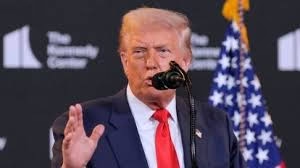U.S. President Donald Trump and Russian President Vladimir Putin met on Friday at a Cold War-era air force base in Alaska for their first face-to-face talks since Trump’s return to the White House. The meeting came amid uncertainty over Trump’s push for a Ukraine ceasefire and a last-minute offer from Putin to negotiate a new nuclear arms control agreement.
Trump, who had once claimed he could end the Ukraine war within 24 hours, admitted on Thursday that the three-and-a-half-year conflict had proven far more complex. He suggested that, if his talks with Putin went well, a three-way summit with Ukrainian President Volodymyr Zelenskiy—who was not invited to Alaska—could follow.
Trump is eager to secure a truce to bolster his credentials as a global peacemaker and position himself as a contender for the Nobel Peace Prize. Ukrainian and European officials, concerned about a potential Trump–Putin deal at Kyiv’s expense, were reassured after a Wednesday conference call in which Trump reportedly agreed Ukraine must be part of any territorial discussions and supported post-war security guarantees for Kyiv.
Putin’s Leverage: Sanctions Relief and Nuclear Deal
Facing mounting pressure from Western sanctions, Putin is seeking U.S. cooperation to ease or halt further restrictions. On the eve of the summit, he dangled the prospect of a new nuclear arms control treaty to replace the last existing agreement, set to expire in February 2026.
Trump expressed optimism, saying he believed Putin “will do a deal on Ukraine,” though his public remarks have alternated between hope and skepticism. Kremlin sources told Reuters that some “common ground” appeared to have been reached before the talks, hinting at the possibility of partial agreements, such as a phased truce in the air war.
Analysts warn Putin could agree to a ceasefire that keeps him in control of escalation, allowing future offensives while giving Trump a diplomatic win.
Disputed Terms and Zelenskiy’s Red Lines
Zelenskiy has dismissed Putin’s overtures as a bluff aimed at buying time and avoiding U.S. secondary sanctions, rejecting any land concessions to Moscow. Trump has suggested land transfers could help break the stalemate—an idea Kyiv firmly opposes.
Putin, whose forces currently control about 20% of Ukraine, wants:
- Full Russian control over the Donbas region (Donetsk and Luhansk)
- Control of Kherson and Zaporizhzhia
- A formal end to Ukraine’s NATO aspirations
- Limits on the size of Ukraine’s armed forces
Kyiv has called these demands unacceptable and equivalent to capitulation.
With the Alaska summit underway, observers say the outcome could range from symbolic progress to a fragile, one-sided ceasefire—leaving the core conflict unresolved but offering both leaders a way to claim success.

